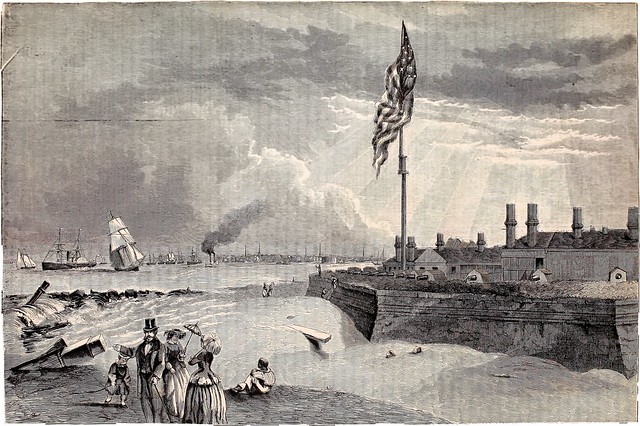 Fort Moultrie (Sullivan’s Island). Charleston, South Carolina in the Distance — Harper’s Weekly, November 17, 1860 (click on image for other sizes)
Fort Moultrie (Sullivan’s Island). Charleston, South Carolina in the Distance — Harper’s Weekly, November 17, 1860 (click on image for other sizes)
THE HARBOR OF CHARLESTON.
(related article from Harper’s Weekly)
We publish on the following page a fine engraving of the City and Harbor of Charleston, South Carolina, showing Fort Moultrie, on Sullivan’s Island, and the entrance to the Palmetto City. It is a surpassingly lovely view, and one which once seen is never forgotten. An eminent Soutisern writer has thus described it, and we can not do better than give his description in his own words
“As you enter from the sea, between the Islands of Sullivan and Moultrie, the city opens before you in the foreground, five miles distant—rising, like another Venice, from the ocean. It is built like Venice, upon flats and shoals of sand and mud. So low is the land, that the illusion that i is built directly in the sea continues til you approach quite near It This illusion is productive of a picturesque effect, but not sufficiently to compensate you for the relief which would be yielded by an elevated background, or by lofty eminences of land on either side. As you advance the bay expands, wide and majestic, forming a harborage to which there can be no objection, were it not for the embarrassments of the bar at the entrance, which forbids the admission of ships of very heavy draught of water. It is a present project with the Charlestonians — supposed to be quite feasible— so to dredge this channel us to remove every difficulty. In that event, Charleston must necessarily acquire a large had imposing commercial marine of her own. In front of you, commanding the channel, is Fort Sumter, a formidable pile of fortress, with double tier of heavy cannon, rising upon a mole at the head of a sand-bar. In passing Sullivan’s Island, the eye readily distinguishes the Moultrie House, famous as a local watering-place; and the still more famous fortress, which also bears the name of Moultrie, distinguished in American history as the scene of one of the first and best-fought battles of the Revolution, when a few hundred native riflemen, who bud never fired a cannon before, beat off, and nearly destroyed, a formidable British fleet, making such slaughter among them as in proportion to the numbers engaged, was not even reached by that of Trafalgar and the Nile. On the right you see Haddrill’s—Mount Pleasant village—which also constituted one of the fortresses of ’76. On the left are the shores of James and Morris Islands, the latter bearing the light-house of the port; the former the site of old Fort Johnson, which was wrested from the British prior to the battle of Fort Moultrie, by the enterprise of a small body of citizen soldiery. Here, at the very portals of the city, you encounter Castle Pinckney, covering an ancient mud reef; and here we propose to give you a bird’s-eye view of the city itself. We are now in the ancient city itself—the Palmetto City! You see the tout ensemble at a glance, and perceive its two most prominent characteristic—the verandas, balconies, piazzas, with the ample gardens and their foliage, which issolate every dwelling-house, and form a substitute for public squares, in which Charleston is lamentably deficient. But for the largeness of the several lots, and the taste of the people for shade-trees, the deficiency would be fatal at once to the health and the beauty of the place.
“This city is one of many beauties, arming from this isolation of the dwellings, and from the ample verdure which girdles them.”